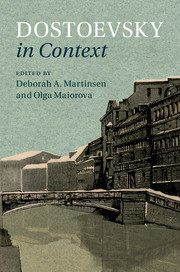Book contents
- Frontmatter
- Contents
- List of illustrations
- Notes on contributors
- Acknowledgments
- Note on citation, transliteration, glossary, and dates
- Chronology
- 1 Introduction: the many worlds of Dostoevsky
- PART I SOCIAL, HISTORICAL, AND CULTURAL CONTEXTS
- i CHANGING POLITICAL, ECONOMIC, AND SOCIAL LANDSCAPE
- 2 The Great Reforms and the new courts
- 3 The abolition of serfdom
- 4 Punishment and crime
- 5 Socialism, utopia, and myth
- 6 Nihilism and terrorism
- 7 The “woman question,” women's work, women's options
- 8 The economy and the print market
- ii POLITICAL, SOCIAL, AND CULTURAL INSTITUTIONS
- iii SPACE AND PLACE
- iv RELIGION AND MODERNITY
- PART II LITERATURE, JOURNALISM, AND LANGUAGES
- Glossary
- Further reading
- Index
- References
5 - Socialism, utopia, and myth
from i - CHANGING POLITICAL, ECONOMIC, AND SOCIAL LANDSCAPE
Published online by Cambridge University Press: 18 December 2015
- Frontmatter
- Contents
- List of illustrations
- Notes on contributors
- Acknowledgments
- Note on citation, transliteration, glossary, and dates
- Chronology
- 1 Introduction: the many worlds of Dostoevsky
- PART I SOCIAL, HISTORICAL, AND CULTURAL CONTEXTS
- i CHANGING POLITICAL, ECONOMIC, AND SOCIAL LANDSCAPE
- 2 The Great Reforms and the new courts
- 3 The abolition of serfdom
- 4 Punishment and crime
- 5 Socialism, utopia, and myth
- 6 Nihilism and terrorism
- 7 The “woman question,” women's work, women's options
- 8 The economy and the print market
- ii POLITICAL, SOCIAL, AND CULTURAL INSTITUTIONS
- iii SPACE AND PLACE
- iv RELIGION AND MODERNITY
- PART II LITERATURE, JOURNALISM, AND LANGUAGES
- Glossary
- Further reading
- Index
- References
Summary
In Dostoevsky's long reflection on the social organization of human life, the idea of socialism and the dream of utopia – an ideal society – were often at the surface and never far apart.
The two first came together for the young Dostoevsky in the 1830s, when as a student in the Academy of Engineers in St. Petersburg, he (like most young Russian intellectuals of the day) eagerly followed what news he could get of life and thought in Western Europe. Most publications from the West were either prohibited or censored by tsarist authorities, but among the least affected were works of fiction in their original languages. Thus it was through the novels of contemporary French writers – above all, George Sand – that Dostoevsky first became acquainted with the socialist theories of Saint-Simon, Fourier, and Leroux, whose plans for harmonious egalitarian communities formed the heart of what came to be called “utopian socialism” – the view, broadly, that the ideal society is one in which all individuals are treated as equals and the means of production are publicly owned, and that furthermore such a society can and should be achieved by voluntary and peaceful means.
The young Dostoevsky worshiped Sand both as a novelist and as a visionary who foresaw a better future for humanity. In a memorial tribute to her in his June 1876 Diary of a Writer, he wrote that “she based her socialism […] on the human moral sense, on humanity's spiritual thirst, on its striving toward perfection and purity.” He maintained that the freethinking Sand was “perhaps one of the most thoroughgoing confessors of Christ even while unaware of being so,” because “her thoughts and feelings coincided with one of the most basic ideas of Christianity, that is, the acknowledgment of the human personality and its freedom” (23:37; WD 1:513).
Dostoevsky's Christianized, moralistic version of zhorzhzandizm, as the Sand enthusiasm came to be called in Russia, drew him together with other reform-minded Russians, and in 1847 he joined a liberal Petersburg circle led by Mikhail Petrashevsky*, an ardent disciple of Fourier. Through the circle's meetings and extensive reading Dostoevsky became thoroughly familiar with the various competing outlines of socialist utopias, but without developing an allegiance to any one particular plan.
- Type
- Chapter
- Information
- Dostoevsky in Context , pp. 39 - 47Publisher: Cambridge University PressPrint publication year: 2016



